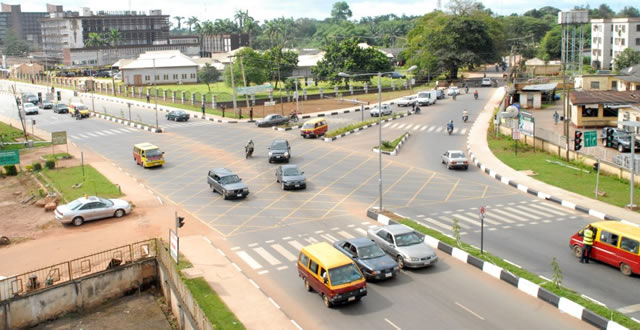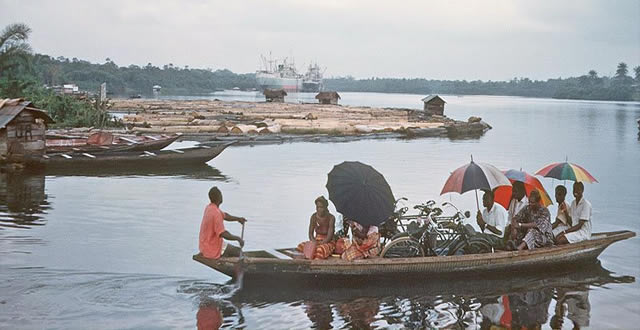
Sapele
Latitude: 5.3221 Lat (DMS) 5° 19' 20N
Longitude: 6.2950 Long (DMS) 6° 17' 42E
Elevation (Feet): 370
Population Est.: 110,205
Zipcode: 331241
History:
Sapele which is today one of the most important industrial port towns in the Western Region of Nigeria was a small village belonging to the people of Okpe in Urhobo country. Sapele, Sapoli, and Sapeli, are the European rendering of the Okpe name of the village which is Urhiapele or Urhuapele. The hinterland Urhobo call it Isapele and the Itsekiri people generally call it Usapele, both obviously after the European rendering. Urhiapele or Urhuapele is a combination of two Urhobo words – Urhie or Urho and Apele. Urhie or Urho means a river or a stream, and Apele is a name of a Juju of the Okpe owners of the village. Urhiapele or Urhuapele therefore means the “River or the stream of Apele.”
Among the Edo-speaking peoples of South-Western Nigeria, there are two groups of people both of whom bear the name Okpe. The first is the Okpe (Urhobo) people of the Delta Province, and the second is a small group in the north of Benin Province. Hubbard has already dealt with the origins of those in the first group while Bradbury dealt with those in the second group.So far, no affinity between the town Okpe groups has been identified.
At a point somewhere about 60 miles from the sea coast, the Benin River divides itself into two branches. In 1839, Mr Robert Jamieson of Glasgow, who had considerable trading interests in the Oil Rivers, named the northern branch of the river after himself. In April, 1840, during his exploration of the Benin River, Mr. John Beecroft named the southern branch Ethiope after the name of the 30 horse-power craft used for the voyage. The craft belonged to Mr. Robert Jamieson, his employer.It is on the left bank of the Ethiope River that Sapele is situated.
The juju "Urhuapele", according to tradition, was said to have belonged to a single family at Orerokpe.It has also been said that it was Onoje, a member of that family and a son of Orhue, who brought the juju from Orerokpe to Sapele. Onoje was one of the founders of Sapele. At Sapele the juju became a communal juju for the whole people of Sapele. After Onoje, his son Basude became the priest, Basude was succeeded by Amune Aparo. When the latter became a Christian, he was replaced by Uboro. The original sacrificial place for the juju was at the waterside near the site formerly occupied by the Messrs. Miller Brothers but now occupied by the Stores of the United Africa Company. It is only a short distance from the Sapele Ferry Landing. The juju still exists but the sacrificial place has been shifted. A small house built for it by its worshipers can be seen in Sapele Urban area near Laborde Street.
The homestead of the Okpe people is Orerokpe. Tradition has it that owing to the autocratic attitude of the Orodje, the people revolted and killed him. After that incident, the people abandoned Orerokpe and settled in groups in different parts of what is known today as Okpe land in Urhobo country. From among those groups of settlers came people like Ijigare, Onoje, Onokuta and Omighodua who were said to be among the founders of Sapele. There is no one alive today who has any idea as to when the revolt at Orerokpe occurred; nor can anyone tell when the subsequent founding of Sapele village took place.
Under the provisions of the European Reservation Proclamation, 1902, a part of Sapele became a Reservation Later, a Board of Health for the Reservation was constituted. The President and Treasurer of the Board was Hugh Jones, Esq., Agent, Messrs Alex Miller Brothers & Company. The significant point to be noted here is that the institution of the Board laid the first foundations of the present local government of Sapele Township.
A major change in the local government set-up took place in 1917, by the enactment of the Townships Ordinance. Under this Ordinance, Order-in-Council No. 19 of 6th September, 1917, made Sapele a Second Class Township. The Senior District Officer became the Local Authority assisted by an Advisory Board. The two members of the Board were the Health Officer and the Chairman of the agents of the trading firms. In September, 1924, Chief A.E. Omarin and Mr. J. A. Thomas wee appointed to the Board. They were probably the first Africans to be so appointed. In later years however, African representation on the Board was increased, but the Township was governed almost entirely alone by the Local Authority who was always a Civil Servant for 38 years.
A new local government system was introduced in September, 1955, by the establishment of the Sapele Urban District Council under the Western Region Local Government Law, 1952. The Council consisted of 33 members, namely, the President, who was the Orodje of Okpe, 8 Sapele Okpe traditional Chiefs and 24 members elected from the local community.
From the above account, it is clear that unlike many towns in the Western Region, but like the present Warri town, Sapele is a new town. Both places came into prominence as from August, 1891, when the Niger Coast Protectorate Government was established. Sapele has always been a rapidly growing town but its present size is not known. In December, 1908 the Government leased for 99 years, 510 acres of the land from the owners. This leased area has not only been developed since to become the present Sapele township, but a considerably large Urban Area has grown alongside it on the southwest and on the north-western side.
Sapele town has always needed some sort of planning. Before the establishment of the Protectorate Government, the original Sapele village was at the sit where the Prison Yard and the Government houses are now; the small market was at the old garage site at Court Road. The Sapele village had town quarters known as Udumurhie and Udumuogo. Udumurhie included the area where the District Officer and the Medical Officer's houses were built at the waterside, and Udumuogo was the Prison Yard area. The original village was vacated for the Government and the Okpe aborigines moved farther out. Chief Ofotoku was living on the site where the present market is, and Chief Ogodo's village was in the area now occupied by the staff buildings of the African Timber and Plywood, Limited. Mclver acquired the lease of the site and Chief Ogodo moved farther down to the Warri road where his village still stands today.
These movements of the aborigines were uncontrolled and the areas occupied unplanned. As they began to sell or give the land around them to strangers, a large unplanned urban area with all type of houses began to grow. And something must be done to the layout of the town. Mr. Palmer tells us that we had Mr. Laborde, District Officer who laid out the town, to thank for the good streets. But it has been a long time from Laborde's days, and the slum in Sapele continues to grow.
Thus in January, 1949 the first Town Planning Authority was appointed. The appointment was long overdue for many years having regard to the rapid and indiscriminate way in which the urban area was developing. Everybody built just what and how he liked without control from the health authorities. On the Town Planning Authority were representatives of the Administration, the Health Department and the Township Board being represented by two of its members. Three members represent Okpe interests and one member from the Amalgamated union of U.A.C. African Workers, Nigeria and Cameroons, represented the interest of workers in Sapele. For the next two years, Chief Arthur Prest and Chief Festus S. Okotie-Ebol (then Chief F.S. Edah) represented the Township Board, while Messrs Rabor Abeke, E. A. Iyefian and J. A. Ayomanor represented Okpe interest.
Within the last ten years, the Sapele Town Planning Authority has been enlarged both in membership and organization. It has now a big separate office of its own. It is present projecting a new development scheme by which the area of the Township is to be extended to include all the parcel of land south of Sapele Urban Boundary and along both sides of Sapele-Warri road. This new acquisition contains an area of approximately 1,840 acres (2.88 square miles).Following the enactment of the Communal Land Rights (Vesting in Trustees) Law No. 45 of 1958, a most significant change in the management of Sapele Township land occurred. Under this law, the Sapele Urban District (Okpe Communal Lands) have been vested in a board of Trustees known as the Okpe Communal land Trustees. The Orodje of Okpe is the Chairman and the other members of the trust are 10 other Sapele Okpe Chiefs. The main functions of the trustees are to demise land for a term of years, to accept surrenders of leases and to be reversioners of any lease so granted. All revenue received in consequences of the exercise of the board's functions are to be applied or disposed of (a) in defraying the expenses of the trustees in carrying into effect their duties (including the management of any lands over which rights of disposition are exercisable and the conduct of legal proceedings in connection with which rights have been vested) and (b) in advancing the education or culture or maintaining the tradition of the Okpe Community. To ensure that the revenue received by the trustees is applied or disposed of in the manner specified above, an Okpe Lands Representative Committee has been established. Under this arrangement, the Government of the Western Region which succeeded to the titles and rights of the former Nigerian government appears to have very little or nothing practically to do with the management of Sapele land.
Sapele Township has for a long time now became a populous town of mixed Nigerian tribes ad other people from different parts of West Africa. A significant fact about the population of Sapele is that it has always included a large number of Europeans for a town of that size. Some of the historical factors responsible for the growth and the cosmopolitan character of the population may be described. Firstly, the transfer of the vice-consular office from Benin River, followed by the removal of the European trading firms at Benin River to Sapele, brought in its wake most of the mixed trading population which had settled in Benin River for many years. Secondly, when in 1894, Chief Nana was captured by the Protectorate Government, the concentrated population of Ebrohimi, was disbanded and many of them resettled at Sapele. A great many of them were Chief Nana's domestics and among them were Uorubas, Ijos, Urhobo, Benins, etc. Thirdly, and this is perhaps by far the most important, the employment opportunities offered by the Sapele rubber plantations and the U.A.C. Sawmill and Plywood factories attracted a large body of people seeking gainful employment. Most people in this third category are Ibos; this factor accounts mainly for the large number of Ibo settlers in Sapele and its environs.
Source: wadoo.org
Banks in Delta
Brief History of Delta
Business and Economy
Festivals and Carnivals
General and Teaching Hospitals
Hotels and Guest Houses
Local Governments & LCDAs
Delta State Ministries Agencies and Parastatals
Police Stations
Popular Markets
Prominent Towns
Restaurants, Bars, Night Clubs
Shopping Malls
Delta State Executive Council
Tourist Attractions
Traditional Rulers
Connect With Us
 |  |  |  |
